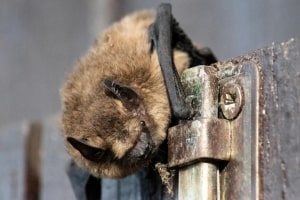 Bats contribute to the ecosystem as natural pollinators and pest control, and they can even be fun to watch as they flutter above in the night sky. However, there is a difference between enjoying wild bats and contending with nighttime visitors in your attic or basement. These flying mammals can cause significant damage to a home, and once they establish a foothold, bat removal becomes incredibly difficult. To prevent an infestation, homeowners in Massachusetts must understand and block the common entry points for bats.
Bats contribute to the ecosystem as natural pollinators and pest control, and they can even be fun to watch as they flutter above in the night sky. However, there is a difference between enjoying wild bats and contending with nighttime visitors in your attic or basement. These flying mammals can cause significant damage to a home, and once they establish a foothold, bat removal becomes incredibly difficult. To prevent an infestation, homeowners in Massachusetts must understand and block the common entry points for bats.
Bats: Good or Bad?
Before you run outdoors to keep bats away from your property entirely, understand that they do shoulder many valuable ecosystem responsibilities. Bats populating the inside of Route 128 eat almost 15 tons of bugs every summer, with the average individual consuming thousands of insects every night. This includes pests, such as mosquitoes, that would be a much greater nuisance without the presence of these flying hunters.
However, bats can also cause problems. If they enter your home, they can quickly establish a colony in a dark, undisturbed location. They produce a significant amount of guano (feces) and urine, which can accumulate quickly into piles that are inches or even feet deep. Not only does this place additional weight on ceilings and other structures, but it also creates a noticeable odor. Over time, the moisture from these droppings stains ceilings, weakens or rots wood, and more. Once the droppings dry, they can release fungal spores if disturbed. Humans who breathe these spores may contract histoplasmosis, a potentially fatal disease, and spores in the eyes may lead to blindness.
How Bats Get Into Your Home
Bats are best left outside your home. To keep them there, identifying the vulnerable points in your house is half the battle.
Cracks
Bats prefer tight spaces, and they can fit into even the tiniest nooks (3/8 of an inch, or roughly the size of a US dime). Examine the exterior of your home for cracks, especially where walls meet or within the eaves. Double-check that your chimney sits flush with the house at all contact points; it is common for chimneys to separate slightly as homes settle.
Vents
 Vents are easy pickings for bats looking for the perfect front door. Attic vents that are not properly secured (e.g., with a mesh screen) are easy access points. Also, check vents and ducts such as those leading to your dryer.
Vents are easy pickings for bats looking for the perfect front door. Attic vents that are not properly secured (e.g., with a mesh screen) are easy access points. Also, check vents and ducts such as those leading to your dryer.
Windows
Windows with a strong seal are effective at keeping bats out, but if the window has pulled away from the wall slightly, that gap is more than enough to let bats in. Be especially vigilant of windows with damaged screens, as they have lost one layer of protection.
Chimneys
If your chimney does not have a damper (the adjustable “door” inside that closes off the outside air) or if the damper is damaged, the chimney serves as a completely open tube through which bats can easily enter. This access point is often how they appear directly in someone’s living area.
Pipes
Anything that goes out of the home requires modifications to the exterior. Vents, electric equipment, plumbing, gas lines, and more may all sit within a small hole or gap. Over time, the caulk and sealant around these spaces can degrade, providing an entry point for winged intruders. The fix for these issues is simple: just repair the caulk.
How to Get Rid of Bats
 If you have already found bats, the next best option is to contact a professional pest control company. Harming bats may be a punishable offense thanks to the ecosystem services they provide, so humane options are required. Your pest control team may recommend the following methods:
If you have already found bats, the next best option is to contact a professional pest control company. Harming bats may be a punishable offense thanks to the ecosystem services they provide, so humane options are required. Your pest control team may recommend the following methods:
- One-way doors: Seal off all potential entrances and exits except for one. Then, construct a door that allows the bats out but not in. Gradually, the bats will leave the home on their own and find a new place to roost.
- Netting: Netting can keep bats out of vulnerable areas, but it can also teach them that their entry point is not safe. A loose net affixed to a board placed over their exit will allow them to leave but prevent reentry.
- Bat houses: Sometimes, bats only choose your home because there is no better option. Installing a properly designed bat house in an ideal location can cause the bats to move of their own volition.
Book Massachusetts Bat Removal Experts
Have you noticed bats in your home? Have you encountered an unpleasant smell, scrabbling noises, or squeaks that you cannot identify? Contact Spartan Animal & Pest Control for an evaluation. We can determine if bats are making your home their own and how they are getting in. Then, we will create a personalized bat removal plan to encourage them to leave humanely so you can get back to enjoying your home in peace!



